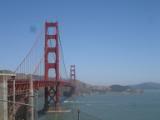San Francisco Sights to See
Golden Gate Bridge
|

|
In
late May of 1937, President
Franklin D. Roosevelt (1882 - 1945) pressed a telegraph
key in the White House back in Washington, D.C. That simple act officially announced an event much
of the world was already anticipating: the opening of The Golden Gate Bridge in San Francisco. After four tough years of construction and a
cost of millions of dollars, and several lives, one of the world's greatest
bridges had been born.
With a span of 4,200 feet (1280m), a record that stood for 27 years,
and two 746 ft (227m) towers the six lane bridge crosses the Golden Gate strait in San
Francisco Bay. The span record held by the Golden Gate
Bridge lasted until the completion of the Verrazano Narrows bridge connecting Brooklyn to
Staten Island
in 1964 and is still disputed owing to differences in the
way measurements are made.
Stretching across some of the most treacherous waters in the world, it
connects the northern tip of the San
Francisco Peninsula to Marin
County near Sausalito.
The Art Deco-themed suspension bridge
masterfully conquers that challenge with aesthetic grace and brilliant
engineering.
It was the brainchild of Joseph
Strauss (1870 - 1938), who outlived his creation by only
the span of a year. But, before he died the genius overcame obstacles nearly everyone
had declared insurmountable.
At the time of its construction it was the largest suspension bridge in
the world erected over a body of cold, swift-current water 400 ft
(122m) deep. The bridge towers remained the world's tallest until
recently.
Joseph Strauss spent over 10 years attempting to get approval for the
project. The financing for the bridge itself took three years to arrange and
wasn't entirely paid off until 34 years later. The $35 million bonds paid their holders
$39 million additional in interest over the period entirely covered by bridge tolls.
But money was the least of Strauss' problems in erecting the structure.
Always concerned with safety, Strauss reduced the death toll on
construction by stringing a large net under the entire span. Though 11
men were killed during construction, 19 were saved by its use. 10 of
the deaths occurred as a result of net failure after a scaffolding
fell. The nineteen who were saved by the net during
construction became proud members of the (informal) Halfway to Hell Club.
Painted in a brilliant orange, the roadway was so popular that even
prior to the official opening hundreds of thousands of visitors crowded
the span for a look. It remains so today. Millions of vehicles have
crossed what is possibly one of the best known bridges in the world,
since 1937.
The only road exiting north of San Francisco, traffic on the bridge is
constant day and night. Its walkways are still often traversed by
pedestrians and bicyclists. The Golden Gate Bridge forms part of U.S. Highway 101, California
Highway 1, but can be reached via Route 30 from Fisherman's Wharf
to Route 28..
Carefully engineered and built to withstand some of the strongest winds
buffeting any bridge in
the world, the span survives the challenge with the aid of its enormous
cables and massive anchorages. The cables are 36.5 inches (92.7cm)
thick, the anchors are sunk in solid bedrock filled with 30,000 cubic
yards of concrete to hold the towers.
Strauss' confidence in his design has been vindicated long after his
passing. In 1951 the bridge had to be closed to traffic due to gale
force winds of seventy miles per hour. Though the deck swayed
twenty-four feet (7.3m) from side-to-side and five feet (1.5m) up and
down, it survived with only minor damage.
Click Here to learn more about San Francisco.
Sitemap
Cities of the World
|

